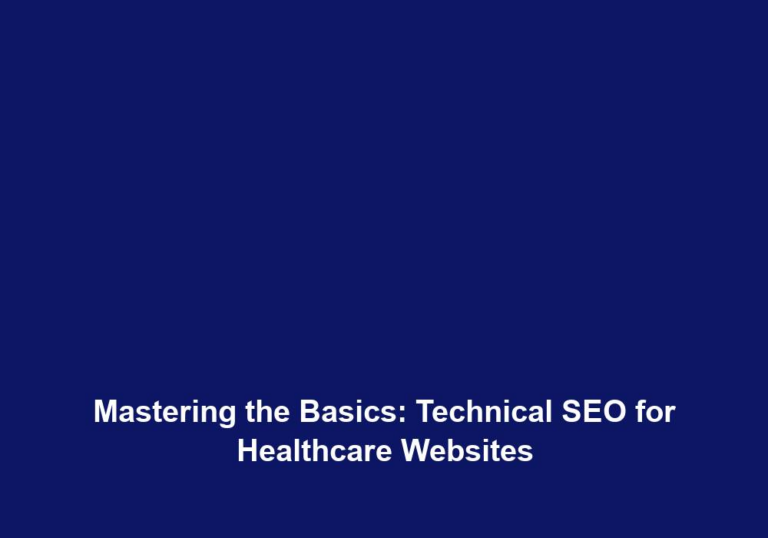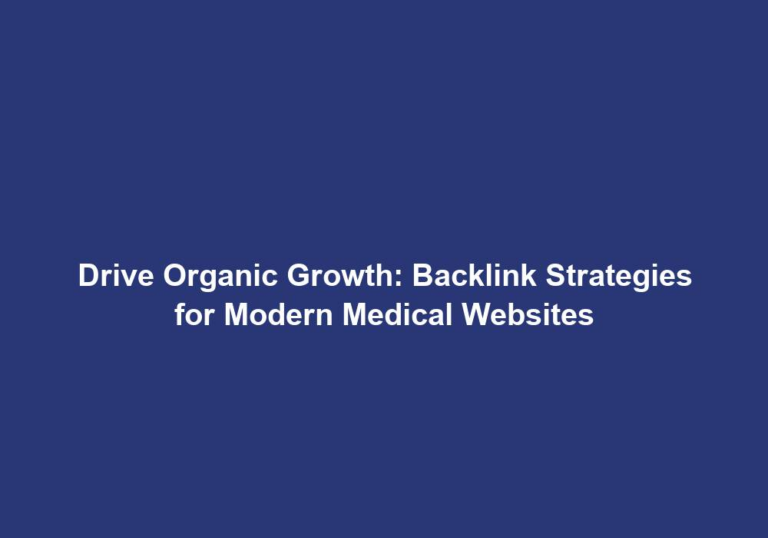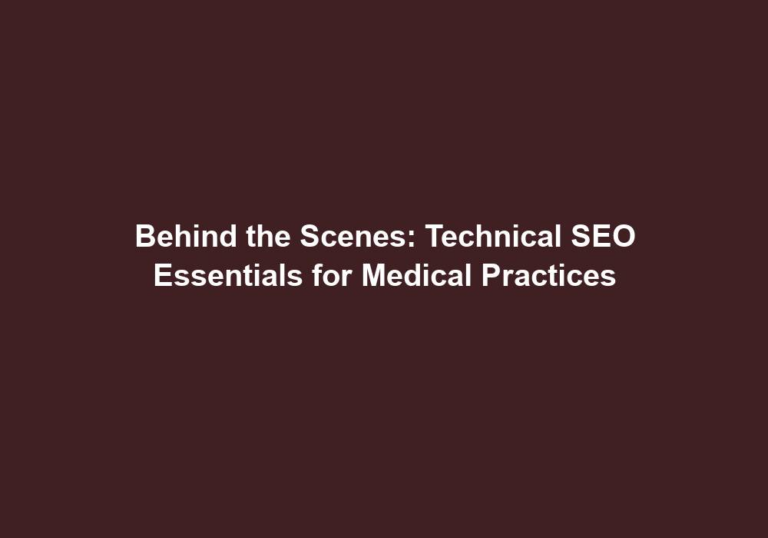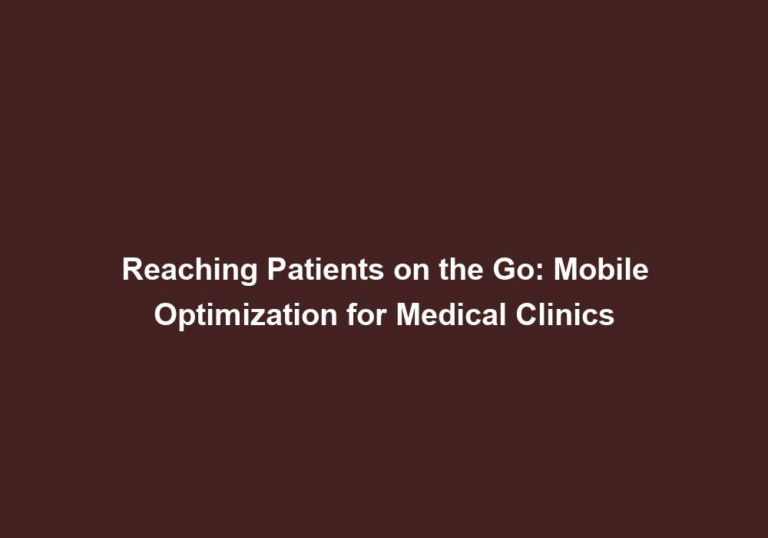Boosting Online Visibility: Technical SEO Fundamentals for Healthcare
In today’s digital age, having a strong online presence is crucial for healthcare providers. With countless websites competing for attention, it is vital to implement effective search engine optimization (SEO) strategies to boost your online visibility. Technical SEO plays a significant role in ensuring that your website ranks higher in search engine results, ultimately driving organic traffic to your healthcare website. In this article, we will explore the fundamental technical SEO aspects that can help healthcare providers enhance their online visibility.
Understanding Technical SEO
Technical SEO involves optimizing your website’s infrastructure and backend elements to improve its search engine crawlability, indexation, and overall user experience. By addressing technical SEO factors, you can enhance your website’s visibility, organic ranking, and user engagement. Let’s delve into the key technical SEO fundamentals for healthcare providers.
1. Website Speed and Performance
Website speed is a critical factor in determining user experience and search engine rankings. A slow-loading website can frustrate visitors, leading to higher bounce rates and lower search engine rankings. To improve website speed and performance, consider the following:
- Optimize image sizes: Compress and resize images to reduce file sizes without compromising quality. This can significantly improve page load times.
- Enable browser caching: Utilize browser caching to store certain elements of your website, allowing for faster page loading upon subsequent visits. This reduces the need to retrieve data from the server, resulting in faster load times.
- Minify CSS, JavaScript, and HTML: Remove unnecessary characters, white spaces, and code comments to reduce file sizes. This improves the efficiency of data transfer and speeds up page rendering.
- Use a Content Delivery Network (CDN): A CDN helps distribute your website’s content across multiple servers worldwide, reducing latency and improving loading times. By serving content from a server closer to the user’s location, you can minimize the time it takes for information to travel.
2. Mobile-Friendly Design
With the rise of smartphones and tablets, having a mobile-friendly website is crucial for both user experience and SEO. Google now prioritizes mobile-friendly websites in its search results, making it essential for healthcare providers to optimize their websites for mobile devices. Consider these tips for mobile-friendly design:
- Use responsive web design: Create a website that automatically adjusts its layout and content to fit different screen sizes and resolutions. This ensures that your website looks and functions well on various devices.
- Optimize for touchscreens: Ensure that buttons, links, and other interactive elements are easily tappable on mobile devices. This improves the overall user experience and reduces frustration.
- Test your website on various devices: Use tools like Google’s Mobile-Friendly Test to ensure your website functions well across different mobile devices. This allows you to identify and fix any issues that may affect user experience or search engine visibility.
3. URL Structure and Site Navigation
Clear and well-structured URLs contribute to better user experience and search engine visibility. When optimizing your website’s URL structure and site navigation, keep the following tips in mind:
- Use descriptive URLs: Include relevant keywords that reflect the content of the page, making it easier for search engines and users to understand. A descriptive URL also improves the click-through rate from search engine results pages.
- Implement breadcrumb navigation: Breadcrumb navigation aids in better user experience by displaying the hierarchical structure of your website and allowing users to navigate back easily. This improves the overall navigation and user engagement.
- Optimize internal linking: Create internal links between relevant pages on your website to enhance search engine crawlability and user navigation. Internal linking helps search engines discover and index pages more effectively, improving overall visibility.
4. XML Sitemap
An XML sitemap is a file that provides search engines with a roadmap of your website’s pages and their relationships. It helps search engines understand and index your content more efficiently. To optimize your XML sitemap:
- Generate a comprehensive XML sitemap: Include all relevant pages and ensure it is regularly updated. This ensures that search engines are aware of all the pages on your website.
- Submit your XML sitemap to search engines: Use Google Search Console and Bing Webmaster Tools to submit your XML sitemap and monitor its performance. This helps search engines discover and index your content more efficiently.
5. Metadata Optimization
Optimizing your website’s metadata helps search engines understand the context and relevance of your web pages. Pay attention to the following metadata elements:
- Page titles (meta titles): Include relevant keywords and ensure they accurately describe the page content. A well-optimized page title can improve click-through rates from search engine results pages.
- Meta descriptions: Craft compelling and concise meta descriptions that entice users to click through to your website from search engine results pages. A well-written meta description can improve click-through rates and user engagement.
- Headers (H1, H2, etc.): Use descriptive headers to structure your content and improve readability. Headers also provide search engines with additional context about your content, helping them understand its relevance.
6. Secure Website (HTTPS)
Website security is crucial for both user trust and search engine rankings. Google has confirmed that HTTPS is a ranking signal, making it essential to secure your healthcare website. Consider the following steps:
- Obtain an SSL/TLS certificate: Purchase and install an SSL/TLS certificate to encrypt data transmitted between your website and users. This ensures that sensitive information remains secure and protected.
- Migrate to HTTPS: Ensure your entire website, including all internal links and resources, use the HTTPS protocol. This provides a secure connection and improves user trust.
By implementing these technical SEO fundamentals, healthcare providers can significantly enhance their online visibility, reach a larger audience, and attract more organic traffic. Remember to regularly monitor your website’s performance and make necessary adjustments to stay ahead of the competition.






